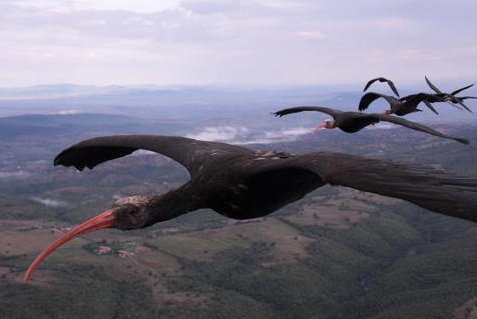Small, lightweight GPS trackers were placed on a flock of ibises in order to track their relative movements, wing speed and wingtip trajectory.(Credit:Mark Unsold)
Birds have been found to fly in a V formation to synchronize their wingbeats and optimize the aerodynamic lift they can get from upwash, the upward flow of air at the front edge of a wing.
Using specialized GPS tracking technology, researchers at the Royal Veterinary College were able to follow a group of northern bald ibises in a microlight aircraft. They placed lightweight GPS trackers on the birds and recorded data on their relative positions, wing speed, heading and when each bird flapped their wings.
On analyzing this data, they found that each bird placed themselves at about four feet behind the bird ahead of them and at a 45° angle. In this formation, the birds were able to catch the rising air, or upwash, of the bird in front of them and thereby expending less energy trying to stay aloft.
Scientists earlier thought that birds were capable of making these subtle variations because of the complex nature of fight dynamics and sensory feedback needed to maintain a smooth flight path. Though the optimal layout of V formation flight had been theorized, it had not been observed in such detail.
“Here we have shown that ibis flight in V formation does, on average, match predictions of fixed-wing aerodynamics, although of course the flock structure is highly dynamic," said Dr. Steven Portugal, lead researcher on the project.
The research is highlighted on the cover of the journal Nature.
Not only did the birds coordinate the flapping of their wings they also followed the same path created by the wingtip of the bird in front of them. They would do this by regulating their wing strokes and were very sensitive to small variations in speed, distance and wingtip path, constantly making small adjustments.
[Royal Veterinary College]
[Nature]















